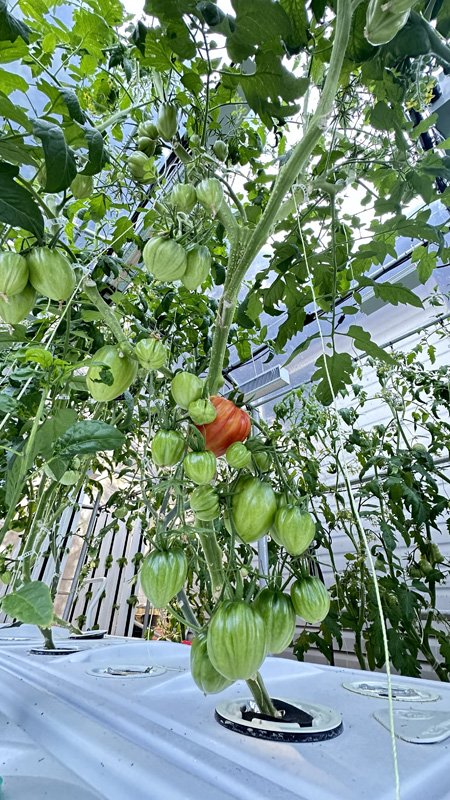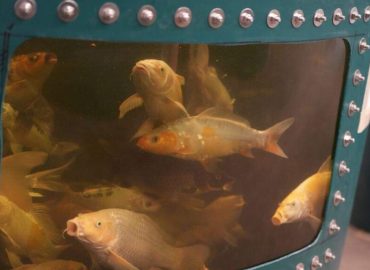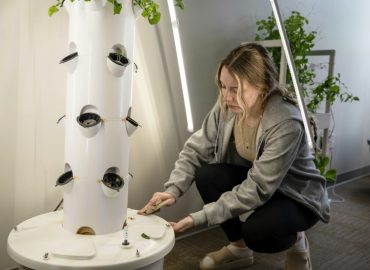Growing Aeroponic Tomatoes

Can You Grow Full-Sized Tomato Plants in Aeroponics?
Growing aeroponic tomatoes indoors or in greenhouses is often limited to compact, quick-finishing varieties like dwarf or patio tomatoes. These setups typically yield grape or cherry types.
But what about full-sized, indeterminate, or determinate varieties that produce large fruit?
The answer is yes—as long as the aeroponic system and growing environment are designed for long-term cropping.
In our real-world case study, we successfully grew a selection of indeterminate heirloom tomato varieties using a modified Current Culture H2O High Pressure Aeroponics (HPA) system. The grow took place in a poly-covered gothic arch greenhouse using natural ventilation, supplemental LED lighting, and smart environmental controls.
The Aeroponics System Setup
The HPA system we used is normally intended for propagation. The main modification involved using SoloComm Lids on the grow modules. These lids are spaced for larger plants and accommodate 5.5-inch net pots and Net Pot Inserts (NPI).
Each lid is 2′ x 4′ with six planting sites. Initially, all sites were used for seedling establishment. Once plants were ready for their final spacing, we transitioned to three plants per module (every other site), resulting in a density of three plants per 8 square feet.
Timeline and Varieties
We started seeds of Giant Polish Paste, Indigo Rose, and Sicilian Saucer in mid-March using the standard CCH2O aeroponic propagation protocol. The first ripe heirloom tomato was harvested July 16—about 120 days from seed to fruit.
Key Questions Answered
Q: Can you grow full-term, full-sized tomato crops in aeroponics?
A: Yes, provided the aeroponic system supports long-term growth, heavy plants, and reliable fertigation misting cycles.
Q: What varieties can be grown in this system?
A: All large-fruited, indeterminate heirloom cultivars tested grew well, producing healthy and abundant yields.
Q: What kind of environment works best?
A: Vertical clearance is essential for indeterminate types. Under light, additional headroom is required. Our greenhouse ranged from 15°C early in the season to over 30°C in summer. Relative humidity varied from 40–80% with natural ventilation and active air circulation.
Propagating Tomatoes in Aeroponics
Seeds were started directly in organic-polymer plugs under LED strips, without fertilizer until the first true leaves appeared. Each propagation lid holds up to 105 plugs. Misting cycles ran 20 seconds on, 5 minutes off. Reservoir temps were kept at 21°C with an aquarium heater.
After 30 days, seedlings were hardened off in the greenhouse under supplemental lighting (SUNaaS – Sun as a Service) before transplant.
Transplanting into Net Pots
After 10 days of acclimation, seedlings were moved into 5.5” net pots using NPIs—no media required. Transplanting was quick and clean, with no delays in growth. Final density was six net pots per 2′ x 4′ module.
Lighting for Aeroponic Tomatoes
We tested two SUNaaS lighting “recipes”: one to enhance root growth, the other to promote compact vegetative growth. Each used custom light spectra to trigger specific plant responses. Both produced desirable outcomes.
Supplemental lighting was especially important during spring months in the Pacific Northwest when natural light can be insufficient.
Greenhouse Conditions
Electric aquarium heaters in the 35-gallon reservoir kept root zones warm, allowing cooler air temps in the greenhouse and saving energy. Since tomato plants are mostly water, keeping root temps optimal is an efficient way to ensure healthy growth.
Motorized shutters and roll-up sides provided passive cooling and dehumidification. A GrowDirector smart controller handled climate regulation and real-time data logging.
Fertigation and System Control
The heart of the system is the programmable HPA pumping station, serving up to 16 modules with 8 high-pressure misting nozzles each.
- EC Range: 0.7 to 1.5 uS/cm using Cultured Solutions liquid nutrients
- pH Range: Maintained between 5.7 and 6.3 using phosphoric acid
- Water: Municipal water filtered for chlorine and sediment
- Water Use: 9 mature plants consumed about 10 gallons/day, depending on light, temp, and humidity
Plant Support & Crop Management
Without a growth medium, plants must be supported early. We used overhead trellising with twine and tomato clips starting around 1 foot in height.
Most plants were pruned and trained to produce 4–6 main branches. To manage height in our 9.5-foot-tall greenhouse, we leaned vines down as needed.
Regular defoliation was critical at this planting density. Weekly leaf removal improved airflow and light penetration. A Leizig Model 12 air circulation fan kept conditions uniform throughout the canopy.
Any Challenges?
The only real challenge we encountered was running out of vertical space—a result of using fast-growing indeterminate varieties in a low-profile gothic arch greenhouse.
Thankfully, this was manageable with pruning and creative trellising—a good problem to have.
Key Advantages of Growing Aeroponic Tomatoes
- Precision fertigation with programmable cycles
- Water-efficient, closed-loop recirculating system
- No media to dispose of or replace
- Seamless, clean transplanting
- Faster growth and strong plant structure
Tomato Yields & Quality
At the time of writing, plants are still producing healthy, flavorful tomatoes. Yields have been excellent, with plants generating layers of trusses and high fruit set—even in variable conditions.Fruit quality is outstanding: large, aromatic, and fleshy. Based on our experience, aeroponic tomato growing not only rivals but surpasses most traditional methods.
The post Growing Aeroponic Tomatoes appeared first on GROZINE.









